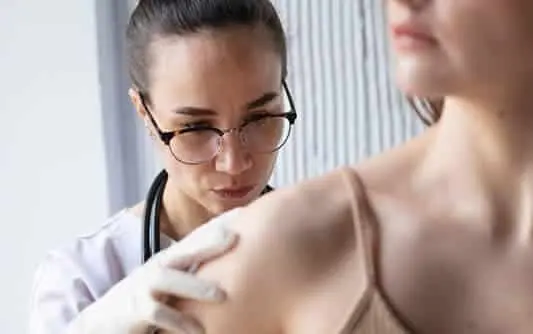Skin cancer is the most common cancer in the United States. Our expert, Saira George, M.D., takes on some common myths about this disease, and has some tips to reduce your risk.
Think you’re safe from skin cancer? It’s the most common cancer in the United States. It’s also one of the most preventable. The primary cause is too much sun or tanning bed exposure.
More than 2 million Americans will be diagnosed with skin cancer this year. Most skin cancers, like basal cell and squamous cell carcinomas, are highly curable. But one form – malignant melanoma – is much more serious.
The good news is you can reduce your risk for skin cancer. It helps to understand your risks and how to protect yourself. Get the truth behind some of these skin cancer myths.
Myth 1: Dark-skinned people don’t get skin cancer.
No one is immune to skin cancer. People of all skin colors, including people who are African-American, Hispanic and Asian, can develop skin cancer.
While skin cancer occurs more frequently in lighter-skinned people, the death rates are higher in darker-skinned people.
“It is often diagnosed later, at a more advanced stage, because both doctors and patients may not even be considering the possibility of skin cancer developing on darker skin until it’s too late” says Saira George, M.D., MD Anderson dermatologist.
Myth 2: I need to get sun exposure to get vitamin D.
You don’t need to bake in the sun to get the vitamin D you need to stay healthy. You get enough of this essential nutrient from typical daily exposure and from food.
“Vitamin D is very important, and we’d be in a bind if the only way to get our levels up was through prolonged sun exposure,” says George. “Luckily that’s not the case. We can get Vitamin D from our diet, and avoid the increased skin cancer risks that come with excessive sun exposure.”
Myth 3: Only sun exposure causes skin cancer.
Sun exposure is the primary cause of skin cancer, but there are other causes:
- Ultraviolet (UV) radiation exposure from tanning beds and occupational equipment
- Family history of skin cancer and other genetic factors
- Increasing age
- A weakened immune system
- People with fair skin and freckles, and multiple or unusual moles also face a higher skin cancer risk.
Myth 4: When it comes to sunscreen, the higher the SPF the better
SPF protection doesn’t increase proportionately with the designated SPF number. SPF 30 absorbs 97% of the sun’s burning UV rays, while SPF 50 absorbs just slightly more – 98%. And, SPF 100 absorbs 99%. So, choose a sunscreen with at least an SPF 30.
“A higher SPF does give you a little extra protection, but it’s still not a perfect block, especially in the real world where we all tend to apply too little and not reapply,” George says. “Your best protection is to stay out of the sun, especially between the peak hours of 10 a.m. and 4 p.m., and to wear protective clothing if you have to be in the sun.”
Myth 5: Sunscreen contains harmful chemicals.
The Food and Drug Administration regulates sunscreens as over-the-counter drugs. The FDA considers sunscreens to be safe and effective.
“We have lots of evidence that shows that too much sun can cause skin cancer and very little that shows current sunscreen ingredients cause any significant harm,” George says. “But I understand the concern people have about chemicals used in everyday products.”
For those who are wary, George says to consider simple mineral sunscreens that contain zinc or titanium oxide.
And remember, you can still be sun smart by covering up, avoiding peak hours of sun exposure, and limit time in the sun.
Myth 6: Only older people get skin cancer.
Prevention counts at any age. Melanoma is the most common form of cancer in young adults age 25-29 and the second most common form of cancer in people 15-29 years old.
And the younger you are exposed to the sun, the higher your risk for getting skin cancer later in life. This is especially true if you have had a blistering sunburn at a young age.
“When it comes to skin cancer, there’s a lot more at play than just age. The biggest factor seems to be your UV exposure over the course of your lifetime, including childhood and young adulthood,” George says.
Myth 7: A base tan prevents sunburns.
There’s no such thing as a safe tan or a tan that prevents sunburns. When ultraviolet rays from the sun or tanning booth hit your skin, they damage the DNA of your skin cells. To protect your cells, your body sends melanin, or pigment, to the surface of your skin. So, your skin gets color at the expense of your health.
“Tanning starts when the body senses that UV damage is occurring. Your body’s skin cells are trying to do the best they can to minimize any further damage but it’s not enough if you get more sun.” George says.
The minor protective effect a tan provides can be easily wiped out by additional UV exposure, leading to more damage. Sunburn happens when the UV rays are more than the skin can handle and repair.
Myth 8: You don’t need to wear sunscreen in the winter or on a cloudy day.
You should protect your skin from UV radiation even when it is not warm or sunny. Harmful UV rays are present year-round and can reach your skin and cause damage even through clouds.
Myth 9: Tanning beds don’t pose a skin cancer risk.
Nothing could be further from the truth. Tanning beds emit the same harmful UV rays as the sun, and in greater amounts.
Using tanning beds increases your skin cancer risk. That includes your risk for the deadliest form of skin.
Schedule a skin cancer screening today with Dermatologist in Chatsworth.

